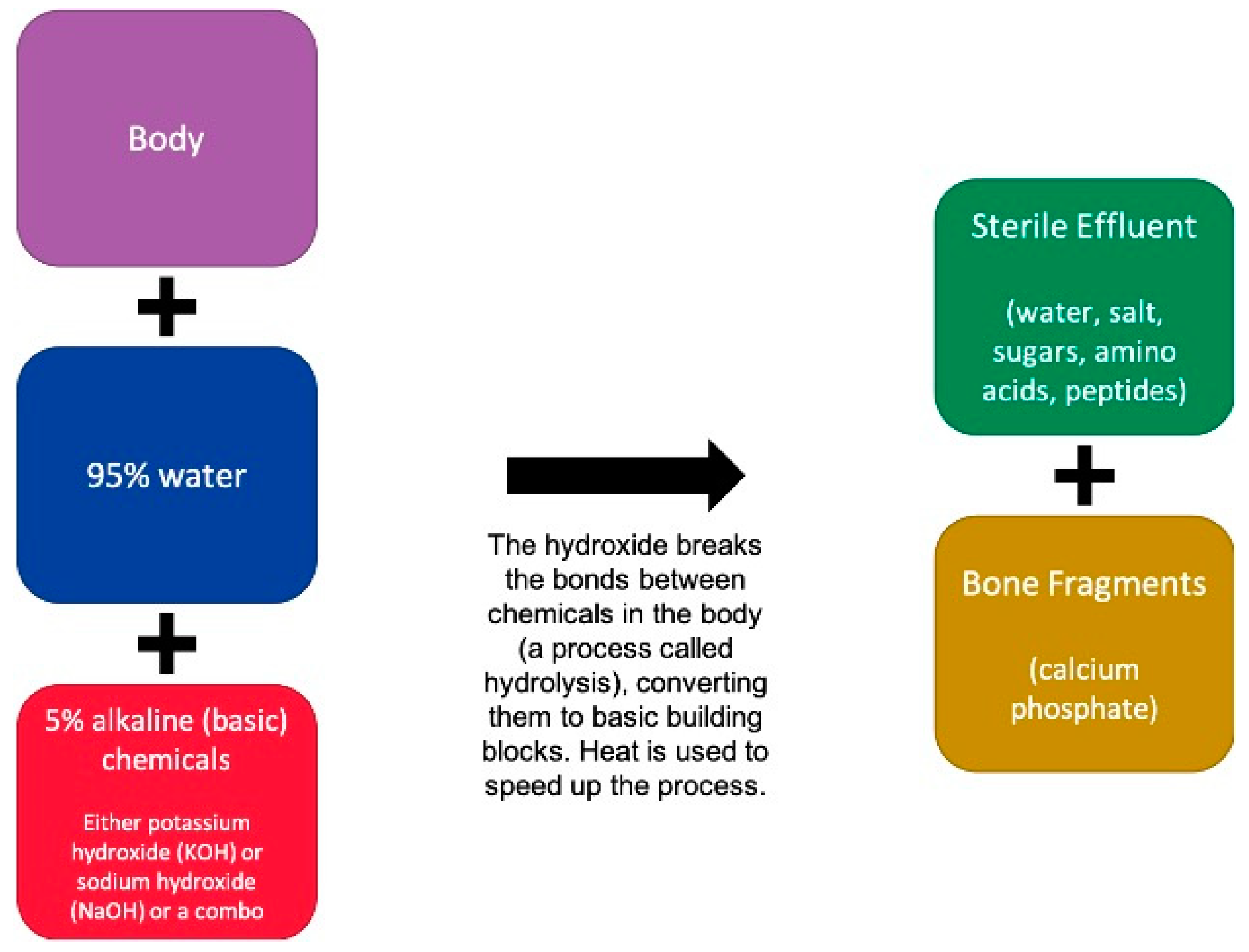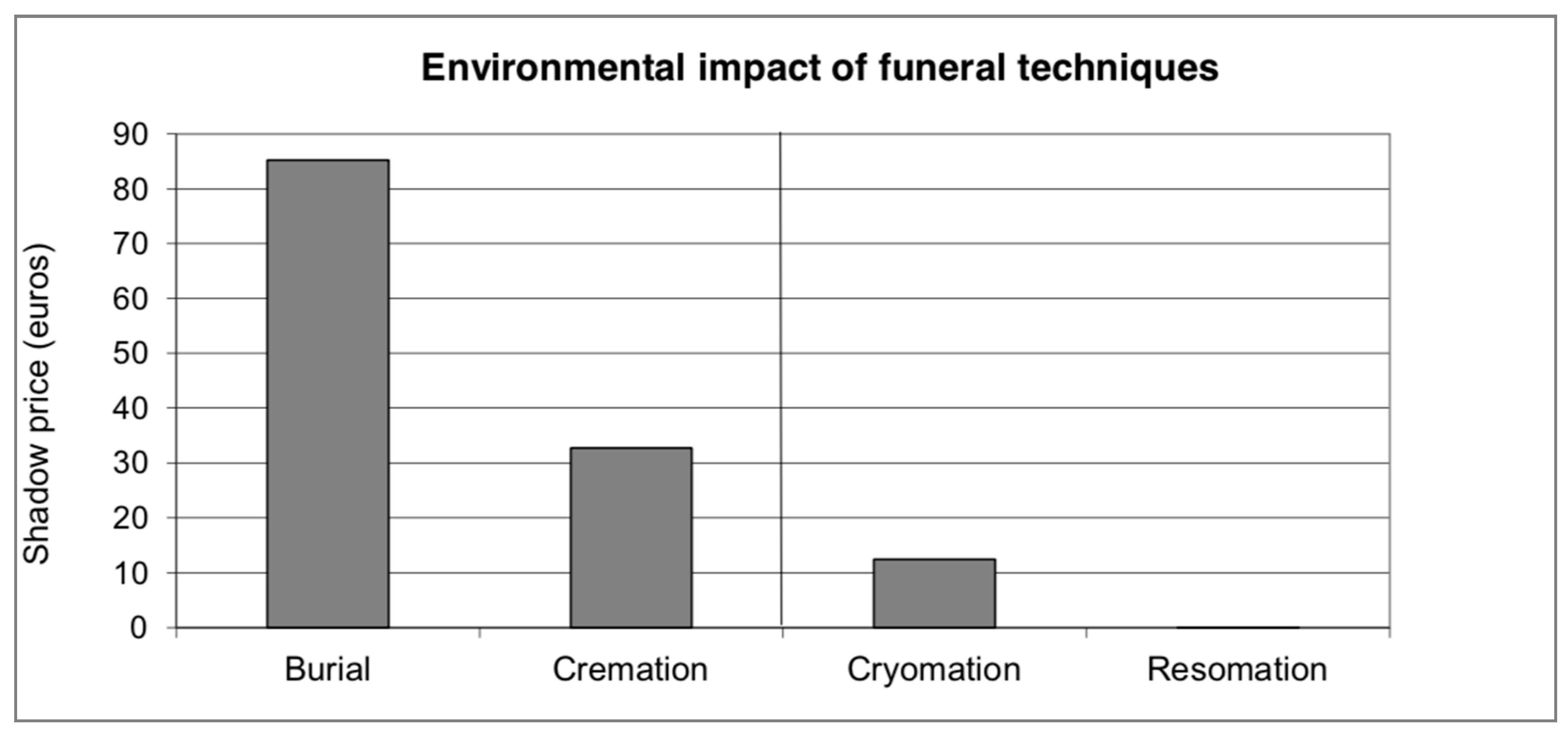Dying to Go Green: The Introduction of Resomation in the United Kingdom
Abstract
:1. Introduction
2. Disposition in the United Kingdom: A Brief History
2.1. Burial
2.2. Cremation
2.3. Natural Burial
2.4. Resomation
2.4.1. What is ‘Resomation’?
2.4.2. Resomation in the Funeral Industry
2.4.3. Resomation and The Cremation Society of Great Britain
‘We, the undersigned, disapprove the present custom of burying the dead, and we desire to substitute some mode which shall rapidly resolve the body into its component elements, by a process which cannot offend the living, and shall render the remains perfectly innocuous. Until some better method is devised we desire to adopt that known as cremation.’.
3. The objectives for which the Society is established are:(1) to promote the practice of cremation for the respectful disposal of bodies and dead persons;(2) to advance public education in the practice and ethics of cremation; and(3) to investigate methods of disposing of the bodies of dead persons which appear to the Society to be superior to cremation and, if the Society thinks fit, to promote such methods and advance public education in their practice and ethics either instead of or in addition to cremation.’
2.4.4. Obstacles Faced by Resomation: Public Perception and Regulations
3. Resomation and Religion
4. Disposal of the Body: Environmental Concerns
4.1. The UK Context
4.2. Problems with Traditional Burial
4.3. Problems with Cremation
4.4. Is This Reported?
4.5. Resomation, Its Environmetnal Credentials, and the TNO Report
5. Conclusions: An Additional Choice—Why Does It Matter?
Supplementary Materials
Funding
Institutional Review Board Statement
Informed Consent Statement
Data Availability Statement
Acknowledgments
Conflicts of Interest
References
- Aftering. 2018. What is Water Cremation? Available online: http://www.aftering.com/how-water-cremation-works-and-why-its-a-21st-century-green-alternative/ (accessed on 9 December 2020).
- Brookes, Tony. 2019. NOx in the City. Pharos International 85: 28–36. [Google Scholar]
- Canning, Louise, Isabelle Swmigin, and Cathy Vaessen. 2016. Consumer acceptance of radical alternatives to human dispoal: An examination of the Belgian marketplace. In Death in a Consumer Culture. Edited by Susan Dobscha. London and New York: Routledge. [Google Scholar]
- Cantor, Norman L. 2010. After We Die: The Life and Times of the Human Cadaver. Washington, DC: Georgetown University Press. [Google Scholar]
- Catholic Bishops of Missouri. 2018. Statement of the Missouri Catholic Bishops on the Disposition of Human Remains through Alkaline Hydrolysis. Available online: https://dioscg.org/statement-of-the-missouri-catholic-bishops-on-the-disposition-of-human-remains-through-alkaline-hydrolysis/ (accessed on 2 January 2021).
- Clayden, Andy, Trish Green, Jenny Hockey, and Mark Powell. 2010. From Cabbages to Cadevers: Natural Burial Down on the Farm. In Deathscapes: Spaces for Death, Dying, Mourning and Remembrance. Edited by Avril Maddrell and James D. Sidaway. Farnham and Burlington: Ashgate. [Google Scholar]
- Clayden, Andy, Trish Green, Jenny Hockey, and Mark Powell. 2015. Natural Burial: Landscape, Practice and Experience. London and New York: Routledge. [Google Scholar]
- Congregation of the Doctrine of Faith. 2016. Instruction Ad Resurgendum cum Christo Regarding the Burial of the Deceased and the Conservation of the Ashes in the Case of Cremation. Available online: https://www.vatican.va/roman_curia/congregations/cfaith/documents/rc_con_cfaith_doc_20160815_ad-resurgendum-cum-christo_en.html (accessed on 8 January 2021).
- Conway, Healther. 2016. The Law and the Dead. Oxon: Routledge. [Google Scholar]
- Cremation Association of North America. 2019. Alkaline Hydrolysis. Available online: https://www.cremationassociation.org/page/alkalinehydrolysis (accessed on 7 December 2020).
- Cremation Society of Great Britain. 1874. Available online: https://www.cremation.org.uk/history-of-cremation-in-the-united-kingdom#declaration. (accessed on 30 October 2020).
- Cremation Society of Great Britain. 1962–1985. CRE/P/7/D/3 Lectures, promotional activities, and background information: Propaganda and advertisement: Transcripts of miscellaneous television and radio broadcasts. In Cremation Society Archive. Durham: Durham University Library Archives and Special Collections. [Google Scholar]
- Cremation Society of Great Britain. 1974. History of Modern Cremation in the United Kingdom 1874–974. Available online: https://www.cremation.org.uk/history-of-cremation-in-the-united-kingdom (accessed on 30 October 2020).
- Cremation Society of Great Britain. 2008a. Annual Report 2008. Available online: https://www.cremation.org.uk/annual-report-2008 (accessed on 30 November 2020).
- Cremation Society of Great Britain. 2008b. Memorandum of Association, dated 22 June 1922, as amended on 14 October 2004 and 17 June 2008. Available online: https://www.cremation.org.uk/content/files/Memorandum.pdf (accessed on 4 December 2020).
- Cremation Society of Great Britain. 2019. Pharos International: Statistics Issue. Maidstone: The Cremation Society of Great Britain. [Google Scholar]
- Cremation Society of Great Britain. 2020. Progress of Cremation in the British Islands from 1885–2019. Available online: https://www.cremation.org.uk/progress-of-cremation-united-kingdom (accessed on 2 January 2021).
- Davies, Douglas J. 1990. Cremation Today and Tomorrow. Bramcote: Grove Books Limited. [Google Scholar]
- Davies, Douglas J. 2005. A Brief History of Death. Malden and Oxford: Blackwell. [Google Scholar]
- Davies, Douglas J. 2015. Mors Britannica: Lifestyle and Death-Style in Britain Today, 1st ed. Oxford: Oxford University Press. [Google Scholar]
- Davies, Douglas J. 2017. Death, Ritual, and Belief: The Rhetoric of Funerary Rites, 3rd ed. London and New York: Bloomsbury Academic. [Google Scholar]
- Davies, Douglas, and Hannah Rumble. 2012. Natural Burial: Traditional-Secular Spiritualities and Funeral Innovation. London: Continuum. [Google Scholar]
- De Spiegeleer, Christoph. 2019. Secularization and the Modern History of Funerary Culture in Europe: Conflict and Market Competition Around Death, Burial and Cremation. Trajecta. Religion, Culture and Society in the Low Countries 28: 169–201. [Google Scholar] [CrossRef]
- Firth, Shirley. 1997. Dying, Death and Bereavement in a British Hindu Community. Leuven: Peeters. [Google Scholar]
- Halevi, Leor. 2007. Muhammad’s Grave: Death Rites and the Making of Islamic Society. New York: Columbia University Press. [Google Scholar]
- Hart van Nederland. 2020. Resomeren na de Dood Straks Toegestaan, Maar Wat is Dat? Available online: https://www.hartvannederland.nl/nieuws/2020/resomeren-toegestaan-wat/ (accessed on 17 November 2020).
- Health Council of the Netherlands. 2020. Admissibility of New Techniques of Disposing of the Dead. Available online: https://www.healthcouncil.nl/documents/advisory-reports/2020/05/25/admissibility-of-new-techniques-of-disposing-of-the-dead (accessed on 30 June 2020).
- Iserson, Kenneth V. 1994. Death to Dust: What Happens to Dead Bodies? Tucson: Galen Press. [Google Scholar]
- Jupp, Peter C. 2006. From Dust to Ashes: Cremation and the British Way of Death. Basingstoke and New York: Palgrave Macmillan. [Google Scholar]
- Keijzer, E. E., and H. J. G. Kok. 2011. TNO Report: Environmental Impact of Different Funeral Technologies. Utrecht: TNO. [Google Scholar]
- Lasnoski, Kent J. 2016. Are Cremation and Alkaline Hydrolysis Morally Distinct? National Catholic Bioethics Quarterly 16: 233–42. [Google Scholar] [CrossRef]
- Leaney, Jennifer. 1989. Ashes to Ashes: Cremation and the Celebration of Death in Nineteenth-Century Britain. In Death, Ritual, and Bereavement. Edited by Ralph A. Houlbrooke. London: Routledge. [Google Scholar]
- Leary, Warren E. 1991. Not Even Death Ends Anti-Pollution Crusade. The New York Times, August 27. [Google Scholar]
- Leming, Michael R., and George E. Dickinson. 2002. Understanding Dying, Death, and Bereavement, 5th ed. Fort Worth: Harcourt College Publishers. [Google Scholar]
- Leuta, Tsepang, and Chéri Green. 2011. Exploring sustainable burial practices in South Africa: Potential challenges and opportunities. Paper presented at the IERM Convention incorporating National Cemeteries Conference, Durban Exhibition Centre, Durban, South Africa, October 25–27. [Google Scholar]
- Litten, Julian. 1991. The English Way of Death: The Common Funeral Since 1450. London: Hale. [Google Scholar]
- Matthews-King, Alex. 2017. Council Plan to Liquefy Bodies in Eco-Friendly Alternative to Cremation Hits Blockage. The Independent, Last Modified 17 December 2017. Available online: https://www.independent.co.uk/news/cremation-councils-death-liquefy-burial-chemical-eco-friendly-a8115321.html (accessed on 17 January 2021).
- Mims, Cedric. 1999. When We Die: What Becomes of the Body after Death. London: Robinson. [Google Scholar]
- Ministry of Justice. 2009. Natural Burial Grounds: Guidance for Operators. Available online: https://assets.publishing.service.gov.uk/government/uploads/system/uploads/attachment_data/file/326362/natural-burial-grounds-guidance.pdf (accessed on 30 November 2020).
- Mirkes, Sr Renée. 2008. The Mortuary Science of Alkaline Hydrolysis: Is It Ethical? National Catholic Bioethics Quarterly 8: 683–95. [Google Scholar] [CrossRef]
- Olson, Philip R. 2014. Flush and Bone: Funeralizing Alkaline Hydrolysis in the United States. Science Technology & Human Values 39: 666–93. [Google Scholar] [CrossRef]
- Podoshen, Jeffrey. 2016. Examining death and learning about life. In Death in a Consumer Culture. Edited by Susan Dobsha. London and New York: Routledge. [Google Scholar]
- Queen’s Bench Division. 1884. The Queen v. Price. Queen’s Bench Division XII, February 7. [Google Scholar]
- Resomation Ltd. 2020. Successful Study of Water Cremation Completed for Yorkshire Water. Available online: https://resomation.com/news/successful-study-of-water-cremation-completed-for-yorkshire-water/ (accessed on 19 November 2020).
- Resomation Ltd. 2021. Saving Our Environment. Available online: https://resomation.com/about/saving-our-environment/ (accessed on 9 December 2020).
- Rothstein, Karla Maria. 2013. Reconfiguring Urban Spaces of Disposal, Sanctuary, and Remembrance. In Our Changing Journey to the End: Reshaping Death, Dying, and Grief in America. Edited by Christina Staudt and J. Harold Ellens. Santa Barbara: Praeger. [Google Scholar]
- Rumble, Hannah, John Troyer, Tony Walter, and Kate Woodthorpe. 2014. Disposal or dispersal? Environmentalism and final treatment of the British dead. Mortality 19: 243–60. [Google Scholar] [CrossRef] [Green Version]
- SAIF. 2020. Water Cremation Gets Green Light. SAIFInsight, May. [Google Scholar]
- Scottish Parliament. 2016. Burial and Cremation (Scotland) Act 2016. Available online: https://www.legislation.gov.uk/asp/2016/20/contents/enacted (accessed on 14 December 2020).
- Sensi, Jasdip. 2020. Successful Study of Water Cremation Completed for Yorkshire Water. Funeral Service Times. Available online: https://www.funeralservicetimes.co.uk/news/2020/03/24/successful-study-of-water-cremation-completed-for-yorkshire-water/ (accessed on 19 November 2020).
- Sloane, David C. 2018. Is the Cemetery Dead? Chicago and London: University of Chicago Press. [Google Scholar]
- Smith, Matthew. 2019. Concern for the environment at record highs. YouGov. Last Modified 5 June 2019. Available online: https://yougov.co.uk/topics/politics/articles-reports/2019/06/05/concern-environment-record-highs (accessed on 4 December 2020).
- Spade, Katrina. 2014. How Your Death Affects Climate Change. HuffPost. Last Modified 2 February 2015. Available online: https://www.huffpost.com/entry/how-your-death-affects-cl_b_6263152 (accessed on 1 December 2020).
- Sue Ryder. 2019. Silence is Deadly: Stigma Attached to ‘the D-Word’ Means Brits are Missing out on a Better Death. Available online: https://www.sueryder.org/news/stigma-means-brits-are-missing-out-on-a-better-death (accessed on 14 December 2020).
- The Competition and Markets Authority. 2018. Funerals Market Study: Qualitative Research Report 2018. St Albans: Research Works Limited. [Google Scholar]
- UK Parliament. 1857. Burial Act 1857. Available online: https://www.legislation.gov.uk/ukpga/Vict/20-21/81/contents (accessed on 14 December 2020).
- UK Parliament. 1902. Cremation Act 1902. Available online: https://www.legislation.gov.uk/ukpga/Edw7/2/8/contents (accessed on 14 December 2020).
- UK Parliament. 2019. The Most Important Issue of Our Time. Last Modified 1 May 2019. Available online: https://www.parliament.uk/business/news/2019/may/mps-debate-the-environment-and-climate-change/ (accessed on 3 December 2020).
- Waterwise. 2012. Water—The Facts: Why do We Need to Think about Water? Available online: https://waterwise.org.uk/wp-content/uploads/2019/10/Waterwise-2012_The-Facts_Why-do-we-need-to-think-about-Water.pdf (accessed on 5 December 2020).
- Whipple, Tom. 2017. Dying to Go Green? Liquefy Your Corpse. The Times, December 18. [Google Scholar]
- World Health Organization. 2017. Life Expectancy, 2000–2016. Available online: https://www.who.int/data/gho/data/themes/mortality-and-global-health-estimates (accessed on 4 December 2020).


Publisher’s Note: MDPI stays neutral with regard to jurisdictional claims in published maps and institutional affiliations. |
© 2021 by the author. Licensee MDPI, Basel, Switzerland. This article is an open access article distributed under the terms and conditions of the Creative Commons Attribution (CC BY) license (http://creativecommons.org/licenses/by/4.0/).
Share and Cite
Robinson, G.M. Dying to Go Green: The Introduction of Resomation in the United Kingdom. Religions 2021, 12, 97. https://doi.org/10.3390/rel12020097
Robinson GM. Dying to Go Green: The Introduction of Resomation in the United Kingdom. Religions. 2021; 12(2):97. https://doi.org/10.3390/rel12020097
Chicago/Turabian StyleRobinson, Georgina M. 2021. "Dying to Go Green: The Introduction of Resomation in the United Kingdom" Religions 12, no. 2: 97. https://doi.org/10.3390/rel12020097





